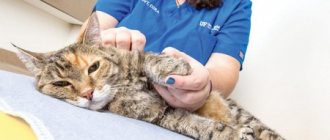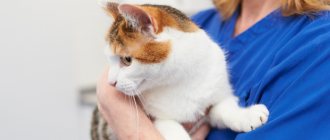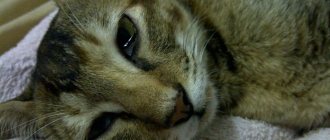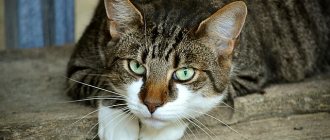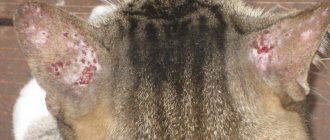Eclampsia or postpartum tetany occurs not only in humans, but also in cats. This disease develops in animals at the stage of bearing or feeding young. The main cause of the pathology is hypocalcemia - insufficient concentration of calcium in the blood. As a result, the animal suffers from convulsive attacks associated with insufficient functioning of the thyroid gland. For the health of the animal, it is extremely important to recognize the disease in time and take measures to cure it. Below is information regarding the symptoms, prevention and necessary treatment of the disease.
Causes and mechanism of development of the disease
During pregnancy, natural changes occur in which calcium from the mother’s body is spent on the formation of the kittens’ skeleton in the womb. Parathyroid hormone is responsible for the absorption and entry of this element into the bones and muscles (it is produced by the parathyroid gland).
Sometimes at the end of pregnancy or after childbirth, the mentioned gland cannot be rebuilt and provide the cat’s increased needs for calcium. As a result, only milk is saturated with it, but not the animal’s body. These processes explain the mechanism of the pathology, and their study allows us to understand how eclampsia develops in cats after birth. Treatment of the disease involves rest and saturation of the body with calcium.
The development of eclampsia is facilitated by poor nutrition and diseases of the digestive system, which impair calcium absorption. Most often, this pathology is diagnosed in primiparous animals. Cats who have given birth to many kittens are prone to it, as their calcium needs are even higher.
Basic information about the disease
Diagnostic methods include a general examination of animals, taking medical history data, conducting serological and laboratory tests.
With eclampsia in cats, changes in pH levels and a decrease in the concentration of calcium in the bloodstream (hypoglycemia) are noted. After diagnosis, cats with eclampsia are prescribed complex therapeutic, etiotropic therapy, which involves intramuscular, intravenous administration of calcium gluconate. In the acute stage - magnesium sulfate. As maintenance therapy, veterinary specialists administer nutritional drips, administration of glucose solution, prednisone, cardiac glycosides, and sedatives (Diazepam). Treatment of eclampsia with corticosteroids requires caution and strict dosage, as they reduce the absorption of calcium in the body.
Animals are prescribed a therapeutic diet rich in calcium, phosphorus, magnesium, a diet, and mineral and vitamin complexes are prescribed. The dosage of calcium, minerals and vitamins is prescribed on an individual basis. Cat owners must provide their animals with complete rest and proper care. Your pet should be protected from stress and any irritating factors.
Kittens are transferred to artificial feeding until the symptoms of the disease in the mother cat completely disappear and her physical condition normalizes. In especially severe cases, animals are transferred to inpatient treatment (hospitalization) in a veterinary hospital.
During acute attacks, you should not treat your cat yourself. You urgently need to call a veterinarian!
With timely diagnosis and timely, effective, correct treatment, the prognosis is favorable. Symptoms of eclampsia in cats go away within 5-8 days.
During pregnancy, natural changes occur in which calcium from the mother’s body is spent on the formation of the kittens’ skeleton in the womb. Parathyroid hormone is responsible for the absorption and entry of this element into the bones and muscles (it is produced by the parathyroid gland).
Sometimes at the end of pregnancy or after childbirth, the mentioned gland cannot be rebuilt and provide the cat’s increased needs for calcium. As a result, only milk is saturated with it, but not the animal’s body. These processes explain the mechanism of the pathology, and their study allows us to understand how eclampsia develops in cats after birth. Treatment of the disease involves rest and saturation of the body with calcium.
The development of eclampsia is facilitated by poor nutrition and diseases of the digestive system, which impair calcium absorption. Most often, this pathology is diagnosed in primiparous animals. Cats who have given birth to many kittens are prone to it, as their calcium needs are even higher.
This condition is observed in cats that are pregnant or have recently given birth. The main reason for the development is an acute lack of calcium in the body.
This mineral is responsible for the formation of bone tissue and joints, and is involved in the regulation of the cardiovascular system. Calcium is responsible for transmitting impulses to nerve endings.
If the body of a pregnant cat does not have enough of this substance for the normal formation of fetuses, calcium begins to be washed out of the bones. As a result, eclampsia develops after childbirth.
The following animals are primarily at risk:
- Cats that have previously suffered from eclampsia, or have relatives with such a disease in their pedigree.
- Animals bearing a large number of kittens (at least 6).
- Pets suffering from chronic or acute diseases of the digestive system.
- Elderly pets (aged 7-8 years and older).
Eclampsia usually develops in the first 30 days after birth. Veterinarians note that any cat can suffer from this disease, regardless of breed.
Cats carrying more than 6 kittens are at risk.
It is very important to take action after the first signs of the disease appear.
READ Causes of dandruff in cats and dogs
If the cat begins to rush around, behaves restlessly, and bites kittens, give her 2.5 ml of Calcium gluconate intramuscularly (it is better to inject 1.25 ml into each hind paw). This drug can be replaced with Borgluconate (it is administered subcutaneously).
If relief does not occur, repeat the procedure after half an hour, but keep in mind that no more than 10 ml of the drug can be administered to the animal per day.
After the acute condition is relieved, Calcium gluconate is given once a day, 2.5 ml for a week. Then the dosage is reduced to 1.5 ml, treatment is continued for another 8-10 days. If there are no obvious signs of eclampsia, Calcium gluconate can be taken orally in the same dosage.
During an exacerbation, you can make a cocktail of drugs and administer it subcutaneously (take the drugs in the given order):
- Borgluconate – 1 ml;
- Glucose 5% (can be replaced with NaCl) – 2 ml;
- Travmatin – 1 ml;
- Gamavit – 1 ml.
If a cat has eclampsia, it is necessary to administer Calcium gluconate or Borgluconate.
The doctor will do tests and prescribe supportive treatment. In case of severe exacerbation, kittens are taken away from the cat for a day or until the animal’s condition returns to normal.
Postpartum tetany or milk fever (synonyms for eclampsia) occurs due to the fact that the animal’s body does not receive the required amount of calcium. This element is especially necessary for the body at the end of pregnancy and in the first months of breastfeeding. This explains the fact that the disease most often occurs in cats at 6-7 weeks of pregnancy and in the first few days after birth.
Eclampsia develops in pregnant and lactating cats.
There is only enough calcium in the animal’s blood to saturate the milk with it. And his mother herself misses him. This leads to sharp contractions of the skeletal striated muscles. Outwardly, these convulsions resemble the clinical picture of strychnine poisoning or the development of tetanus.
Since the symptoms of eclampsia after childbirth are quite similar to the signs of other diseases, only a veterinarian can make an accurate diagnosis.
To do this, you will need to carry out a number of activities:
- Get information about the animal's life, previous pregnancy, childbirth and the postpartum period.
- Conduct an examination of the animal to exclude neurological diseases, spinal cord and brain injuries.
- Determine calcium concentration using a biochemical blood test.
If there are signs of eclampsia, the veterinarian will draw blood from the cat to determine calcium levels.
In addition to calcium levels, the doctor will also prescribe a blood test for sugar, a decrease in which can also accompany eclampsia.
Symptoms
There are a number of characteristic signs that occur with a disease such as eclampsia in cats after birth. Symptoms in an animal on the first day after the birth of offspring are usually the following:
- restless behavior;
- dry mucous membranes;
- a strange attitude towards its kittens (instead of caring, the cat may run away from them or constantly drag them from one secluded place to another);
- muscle twitching;
- dyspnea;
- constantly wide pupils and the absence of their reflex narrowing, even in bright light.
Later, these manifestations of eclampsia may be accompanied by convulsions, increased body temperature to 40 °C or higher, and fainting. At the first alarming symptoms, the cat should be shown to a veterinarian to establish an accurate diagnosis and develop a treatment regimen. It is important for the doctor to conduct a differential diagnosis with epilepsy and tetanus and assess the severity of the disease. This is necessary to determine whether the animal requires hospital treatment or can be cared for at home.
First aid for an animal
Before the veterinarian arrives, the cat needs emergency care. This will increase the chances of recovery and a favorable outcome. Since eclampsia in cats can develop within a few hours, you need to act quickly. Here's how you can help at home:
- temporarily isolate the sick animal from the kittens;
- provide complete rest for the cat;
- in the room where the pet is located there should be dim light and fresh air;
- if your body temperature is elevated, it can be lowered with cool, damp towels or an ice pack wrapped in a cloth;
- In case of seizures, the animal must be covered with pillows or blankets so that it does not hit or injure itself during an attack.
The cubs need to be provided with artificial nutrition, since eclampsia of a nursing cat is a contraindication to natural feeding. Kittens should be kept in a separate room until their mother is fully recovered, so that she does not accidentally harm them.
How is the treatment carried out?
Typically, eclampsia requires immediate emergency treatment. The body is in a hopeless situation: it requires calcium, but its reserves have depleted, and there is no longer an opportunity to get it with food. With this disease, the cat loses its appetite and digestion is disrupted, so adding calcium supplements to the food is pointless. The only way out is to treat the animal by injecting calcium supplements into the blood.
READ Colds in cats treatment at home - Colds
The recovery process and the treatment regimen itself depend on the moment at which the animal owner seeks help from a specialist. Treatment at home can lead to the death of the cat, since in most cases emergency administration of calcium supplements is necessary. Otherwise, the pet may die from heart failure.
In late pregnancy, the cat will have a caesarean section and will be given calcium supplements for the next 7-10 days. If eclampsia is diagnosed in a nursing cat, it will require temporary isolation from the kittens. This is required so that the animal can recover in complete peace. At this time, kittens are fed artificially.
Treatment with calcium gluconate
Impaired calcium absorption and autointoxication of the body due to the accumulation of postpartum secretions in the uterus lead to a disease such as eclampsia in cats. Treatment at home should be etiotropic, that is, eliminating the cause. The main drug for replenishing the deficiency of the missing microelement is calcium gluconate. After consulting a veterinarian, the medicine can be administered intramuscularly at home.
The dose of calcium gluconate should be determined by the doctor, but on average, to relieve an attack of eclampsia, intramuscular administration of 1 ml of a 10% solution is recommended at intervals of 40 minutes until the characteristic symptoms cease.
To eliminate swelling, the animal can additionally be prescribed Prednisolone, and to eliminate muscle spasms, Drotaverine (No-Shpa). After acute symptoms are relieved, the cat is usually administered intramuscular calcium gluconate twice - morning and evening - 1 ml for 7-10 days.
How doctors will treat a cat
Treatment should be comprehensive - eliminating life-threatening symptoms and restoring normal calcium levels in the blood. The standard set of drugs that veterinarians give to animals with attacks of eclampsia:
- Ca Gluconicum dropper (10% solution at a dosage of 15 mg per kilogram of cat weight) - for 30–40 minutes. It is carried out only in a clinical setting, since simultaneous ECG monitoring is required.
- Barbiturates intravenously to eliminate dangerous overexcitation of the central nervous system.
- Diazepam for anticonvulsant and muscle relaxant effects is administered intravenously at a dose of 0.1 mg per kilogram of the patient’s weight.
- Antipyretics to eliminate signs of hyperthermia.
Once the cat is brought out of critical condition, it can be taken home. Within a week, the owner will have to inject the animal with calcium borogluconate in the dosage prescribed by the veterinarian. It is recommended to separate cats with eclampsia from their kittens; the female will have to artificially feed the cubs during the period of treatment.
What else can you do to help at home?
Since eclampsia in cats is accompanied by the accumulation of toxic metabolites in the body, the animal needs to be provided with detoxification therapy. This can be done at home by drinking plenty of fluids. This method of oral fluid replenishment and elimination of toxins is analogous to an IV in a hospital.
The cat should be in a quiet place, protected from light and harsh sounds. The animal should not experience tension or stress, as these conditions can lead to deterioration and frequent seizures. It is necessary to monitor the condition of the mammary glands, checking them several times a day for soreness and the presence of lumps. If necessary, milk can be slightly strained to prevent the development of a concomitant disease - mastitis.
Restoring your cat's health
Eclampsia debilitates a cat, and even after complete recovery, its body needs careful treatment and support. Your pet needs a balanced diet; it should contain dairy products every day (ideally, if they make up a third of the total daily food).
It would be advisable to take vitamin and mineral supplements with calcium, which can be selected by a veterinarian. After recovery, you need to treat the animal kindly, do not tease it or wake it up if it is sleeping. It is advisable to completely transfer kittens to artificial feeding so that the cat does not develop calcium deficiency again.
In what situations can a disease not be treated at home?
Eclampsia is a disease that, if not properly treated, can lead to the death of an animal. A cat can die due to high body temperature (above 41 °C) or due to brain damage and depression of the respiratory center.
There are signs of eclampsia in cats, which indicate a severe course of the disease and the need for hospital treatment. If after the start of therapy there is no improvement in the animal’s condition for a couple of hours, this may indicate the need for intravenous infusion of the drug.
In cases of prolonged increase in body temperature, which is not brought down by medication and home methods, it is also recommended to hospitalize the cat. This must be done to avoid destruction of protein structures and the development of severe seizures. In the hospital, it is possible to administer medications under ECG monitoring, which makes it possible to recognize cardiac disorders in time and begin to fight them.
Characteristic clinical signs
The symptoms of the disease are pronounced, so it is almost impossible to miss the signs of eclampsia.
These include:
- Refusal to feed and increased salivation.
- Increased temperature and irregular heart rhythm.
- Frequent breathing and depression.
- Paleness of the conjunctiva and mucous membranes.
- Behavioral disturbance - the animal begins to worry or, on the contrary, behaves inhibited. Concern for the kittens increases, the cat hides them or moves them from one place to another. The mother can also abandon her offspring.
Severe symptoms include:
- loss of consciousness;
- presence of seizures;
- numbness of some parts of the body;
- loss of coordination.
All these signs of milk fever are increasing. And you need to be able to notice them in time and take the necessary measures.
Prevention
The main role in preventing such a dangerous phenomenon as eclampsia in cats is played by a complete, balanced diet during pregnancy. It should not only have calcium deficiency, but also its excess. The intake of high doses of this element from food into the body during pregnancy can lead to malfunctions of the parathyroid gland and become an indirect cause of the development of metabolic disorders in the future.
If an animal has already been diagnosed with eclampsia during a previous birth, then you should try to maximize the interval until the next pregnancy. In this case, you should approach nutrition issues with particular care and be sure to undergo veterinary examinations on time.
Causes of eclampsia in cats
Today there are more than 30 theories of the origin of this disease. In each of them, the leading role remains with calcium. But what exactly triggers this process is not yet known exactly.
Scientists have identified only a few reasons for the development of postpartum tetany:
- Pathology. It is observed mainly in firstborns.
- Gastrointestinal diseases. With some digestive problems, calcium, like some other microelements, is simply not absorbed by the body.
- The calcium-phosphorus ratio does not meet the physiological needs of the animal.
- Lack of normal nutrition in a cat during pregnancy and after birth.
Improper feeding of a cat during pregnancy is one of the causes of eclampsia.
Considering the above reasons for the development of the disease, pet owners should pay close attention to the health of their cat during pregnancy and after childbirth.




